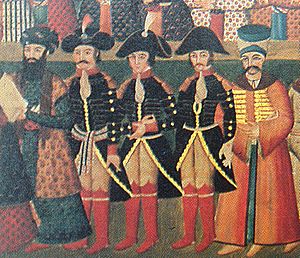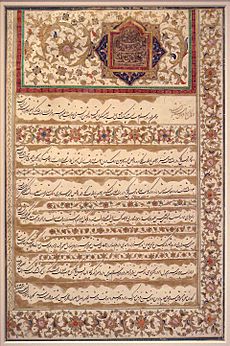Fath-Ali Shah Qajar facts for kids
Quick facts for kids Fath-Ali Shah Qajar |
|||||
|---|---|---|---|---|---|
| Shahanshah Khaqan |
|||||
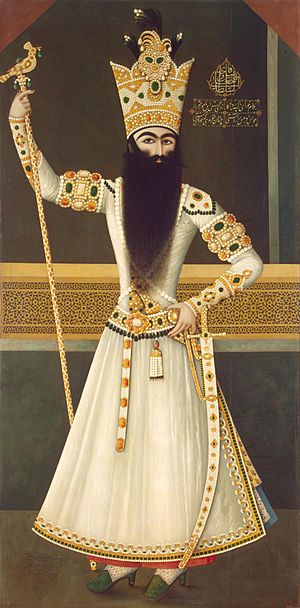
Portrait by Mihr 'Ali, between 1809–1810 (Hermitage Museum)
|
|||||
| Shah of Iran | |||||
| Reign | 17 June 1797 – 23 October 1834 | ||||
| Predecessor | Agha Mohammad Khan Qajar | ||||
| Successor | Mohammad Shah Qajar | ||||
| Grand viziers |
See list
Hajji Ebrahim Shirazi Mirza Shafi Mazandarani Hajji Mohammad Hossein Khan |
||||
| Born | May 1769 Damghan, Zand Iran |
||||
| Died | 24 October 1834 (aged 65) Isfahan, Qajar Iran |
||||
| Burial | Fatima Masumeh Shrine | ||||
| Spouse | Numerous wives, including Taj ol-Dowleh, Kheyr-ol-Nessa Khanom, Sanbal Baji, Badralensa Khanum and Maryam Khanom |
||||
| Issue Detail |
Mohammad Ali Mirza Abbas Mirza Ziaʾ al-Saltaneh Hossein Ali Mirza |
||||
|
|||||
| Dynasty | Qajar | ||||
| Father | Hossein Qoli Khan | ||||
| Mother | Agha Baji | ||||
| Religion | Shia Islam | ||||
| Tughra |  |
||||
Fath-Ali Shah Qajar (Persian: فتحعلىشاه قاجار, romanized: Fatḥ-ʻAli Šâh Qâjâr) was the second king, or Shah, of Qajar Iran. He ruled from June 17, 1797, until his death on October 24, 1834. During his time as king, Iran lost important northern lands in the Caucasus region to the Russian Empire. These lands include parts of what are now Georgia, Dagestan, Azerbaijan, and Armenia. This happened after two wars with Russia, known as the Russo-Persian Wars, and the signing of the Gulistan and Turkmenchay agreements.
Fath-Ali Shah is remembered for his very long beard, his slim waist, and having many children. Towards the end of his rule, Iran faced big money problems and was behind in military technology. This led to difficulties for the government, and a fight for the throne happened after he died. He also had many pictures and carvings made of himself and his court. These were created to show the power of the king and connect him to ancient Persian rulers.
Contents
Early Life and Becoming King
Fath-Ali Shah was born in May 1769 in Damghan. His first name was Fath-Ali, but he was mostly known as Baba Khan until he became king in 1797. He was the oldest son of Hossein Qoli Khan Qajar. When he was five, Baba Khan was sent to the court of the Zand ruler Karim Khan Zand in Shiraz as a hostage. This was because his father was suspected of planning a rebellion. There, he joined his uncle, Agha Mohammad Khan Qajar, who was also a hostage.
After Karim Khan died in 1779, Baba Khan joined his uncle Agha Mohammad Khan. His uncle later became his stepfather and guardian. Baba Khan helped his uncle in wars and became governor of Fars. When his uncle was killed in 1797, Baba Khan became the new king and took the name Fath-Ali Shah.
His rule brought a rebirth of Persian art, especially paintings and large oil portraits. He personally supported many artists. He also ordered the creation of royal items like the "Sun Throne," the "Naderi Throne," and the "Kiani Crown." These items were decorated with many pearls and gems. In 1797, he received a full set of the Britannica's 3rd edition and read it all. He even added "Most Formidable Lord and Master of the Encyclopædia Britannica" to his royal titles!
Wars with Russia
First Russo-Persian War (1804–1813)
Early in Fath-Ali Shah's reign, Imperial Russia took control of Georgia. Iran had ruled this area off and on since 1555. Georgia had allied with Russia, Iran's rival. Fath-Ali Shah's uncle had attacked Georgia to bring it back under Persian rule. However, after his uncle was killed, Russia officially took over parts of Georgia in 1801. Russia also invaded Dagestan, which had been under Persian rule.
Fath-Ali Shah saw this as an attack on Persian land. He wanted to get these territories back. So, he declared war on Russia in 1804 after a Russian general attacked the city of Ganja. The war started well for Persia, but Russia had better weapons and cannons. Persia asked Britain for help, based on a military agreement, but Britain refused.
Persia then asked France for help and signed an agreement with Napoleon. But Napoleon later made peace with Russia, so France didn't help. Russia then increased its efforts in the Caucasus region. In 1813, Russian troops attacked Lankaran and Tabriz. Persia was forced to sign the Treaty of Gulistan.
Treaty of Gulistan (1813)
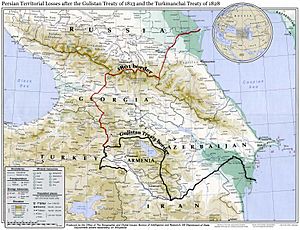
After several defeats, Fath-Ali Shah had to sign the difficult Treaty of Gulistan on October 24, 1813. This treaty gave many cities, towns, and villages in Georgia, along the Black Sea, and in the South Caucasus and North Caucasus to Russia. These areas include modern-day Georgia, southern Dagestan, and most of present-day Azerbaijan. In return, Russia promised to support Abbas Mirza as the next king of Persia after Fath-Ali Shah died.
Second Russo-Persian War (1826–1828)
Thirteen years after the first war, Fath-Ali Shah decided to try and get back the lost territories. His son, Crown Prince Abbas Mirza, led an army of 35,000 soldiers into the Talysh Khanate and Karabakh khanate in July 1826. The first year of the war was very successful, and Persia regained many of the lands lost in the previous war.
However, things changed after winter. In 1827, Russian forces invaded more areas, including Echmiadzin and Erivan. In January 1828, the Russians reached Lake Urmia. Abbas Mirza quickly signed the Treaty of Turkmenchay on February 2, 1828.
Treaty of Turkmenchay (1828)
The Treaty of Turkmenchay was signed on February 21, 1828. With this treaty, Iran lost all its remaining lands in the Caucasus, including most of modern-day Armenia and parts of Azerbaijan. Iran also had to pay Russia a large sum of money (10 million in gold). In return, Russia again promised to support Abbas Mirza as the next king. The treaty also allowed Armenians living in Persia to move to the Caucasus.
Later Life and Legacy
Fath-Ali Shah later had writers and painters create a book about his wars with Russia. This book, called the Shahanshahnama, was inspired by the famous Persian epic Shahnameh.
In 1829, a Russian diplomat was killed at the Russian embassy in Tehran. To apologize, the Shah sent his son, Prince Khosrow Mirza, to Tsar Nicholas I. He also sent one of the biggest diamonds from his crown jewels, known as the Shah Diamond.
When his favorite son and crown prince, Abbas Mirza, died in 1833, Fath-Ali Shah named his grandson, Mohammad Mirza, as the new crown prince. Fath-Ali Shah died a year later, on October 24, 1834. He was buried in a tomb at the Fatima Masumeh Shrine in Qom.
He is easy to recognize in his portraits because of his very long, dark beard that reached below his waist. During his rule, Fath-Ali Shah successfully changed his kingdom from a group of tribal areas into a strong, centralized monarchy, similar to ancient empires.
Appearance and Titles
Fath-Ali Shah was the last Qajar king to dress in the traditional Persian way. This included a decorated long robe, high heels, and his famous long beard. A Scottish historian who met him in 1800 described him as "above the middle size, his age little more than thirty, his complexion rather fair, his features regular and fine, with an expression denoting quickness and intelligence."
He used two important titles: shahanshah (meaning "King of Kings" from ancient Persia) and khaqan (meaning "khan of khans" from Turkic-Mongol traditions). This showed that he was both the ruler of the country and the leader of its tribes.
Family and Children
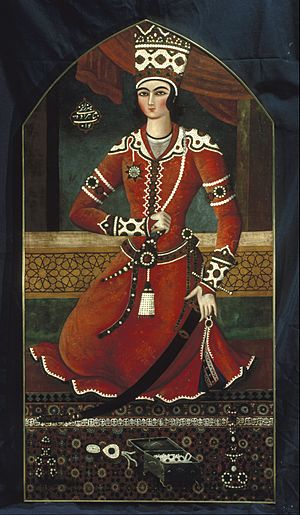
Fath-Ali Shah is said to have had many spouses and a very large family. He had 57 sons and 46 daughters who survived him. He also had hundreds of grandsons and granddaughters. While he had many children, he does not hold the record for the most children born to one man.
His first son, Mohammad Ali Mirza Dowlat Shah, was a few months older than his second son, Abbas Mirza. However, Abbas Mirza was chosen as the crown prince. This was because Mohammad Ali Mirza's mother was not from the Qajar family, so his younger brother was chosen instead.
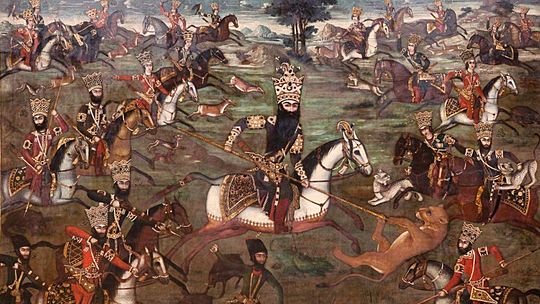
- Some of his notable sons included:
- Mohammad Ali Mirza 'Dowlatshah' (1788–1821)
- Abbas Mirza 'Nayeb os-Saltaneh' (1789–1833)
- Hossein Ali Mirza 'Farman Farma' (1789–1835)
- Abdollah Mirza 'Dara' (1796–1846)
- Mahmud Mirza (1799–1835)
- Soltan Mohammad Mirza 'Sayf ol-Dowleh' (1812–1899)
- Yahya Mirza (1817)
- Aliqoli Mirza 'Etezad os-Saltaneh' (1822)
- Soltan Ahmad Mirza 'Azod od-Doleh' (1824–1901)
- Jalal al-Din Mirza 'Ehtesham ol-Molk' (1826)
- Some of his notable daughters included:
- Ziaʾ al-Saltaneh (1799–1873)
- Khadijeh Soltan Begom, "Esmat-ad-Dowleh"
- Sarv-i Jahan Khanum
See also
 In Spanish: Fath Alí Sah para niños
In Spanish: Fath Alí Sah para niños


